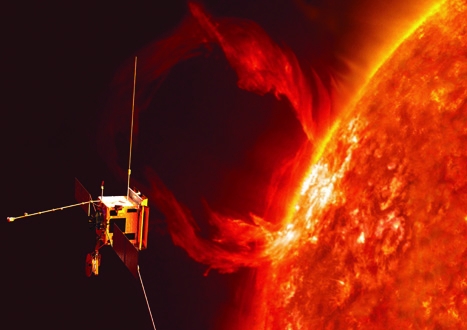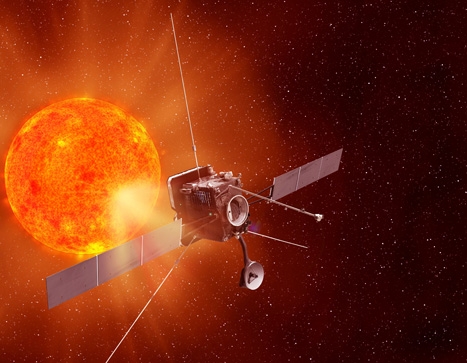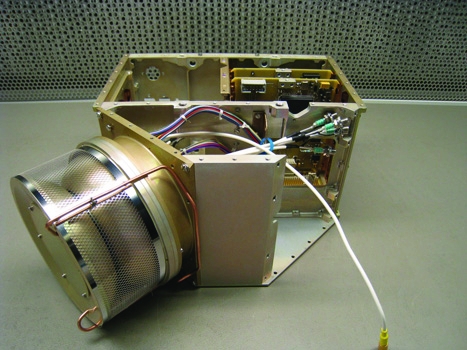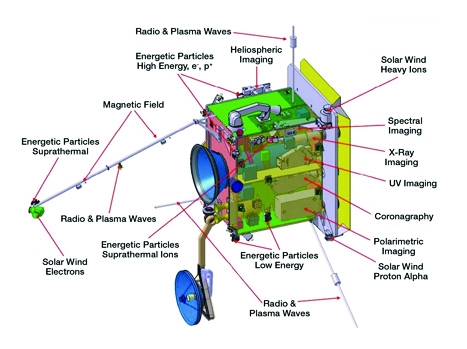The influence of the Sun is all-pervasive. The massive ball of fusing hydrogen at the centre of the Solar System drives life on Earth, the weather and, ultimately, most of the processes on the planet. Its gravity keeps the other planets, the asteroids and myriad comets, dust particles and many other chunks of matter in their orbits. And it spews out a constant, ferocious stream of charged particles into space for millions of miles in all directions — the phenomenon known as the solar wind. It’s also found its way into our folklore — in particular, stories about what happens when you get too close to it. From the ancient Greeks’ tale of Icarus to the Danny Boyle film Sunshine (and taking in a memorable episode of the puppet epic Thunderbirds on the way), we’re not short of warnings about the dangers of approaching the Sun.

But that’s not deterring space scientists. Solar research is a hot topic, and scientists and engineers from both the US and Europe are currently preparing missions that will approach the Sun more closely than ever before, in an effort to discover how our stellar neighbour influences its surroundings and what the implications of that may be for us, and our technologies, on Earth.
Investigating the magnetic fi eld is vital to understanding how the solar wind moves through space
The first to launch, in 2017, will be the European Space Agency’s (ESA’s) Solar Orbiter. Being built at EADS Astrium in the UK, the probe will cross the orbit of Mercury, approaching as close as 60 solar radii (26 million miles or 43.4 million kilometres) from the Sun’s surface - almost three quarters of the distance from the Earth to the Sun. Once there, it will deploy a battery of instruments to take two sets of measurements: one of the conditions around it, looking at the characteristics of the magnetic field, the particles of the solar wind and the radiation flux that surrounds it; and the other using telescopes that will look directly at the disc of the Sun itself, trying to relate the processes that are happening on and inside the star to the influence it has out in space.
The second probe will approach still closer. NASA’s Solar Probe Plus will fly to 8.5 solar radii of the Sun’s surface (3.7 million miles or 5.95 million kilometres) to sample the solar winds and magnetic field at even closer quarters (see box opposite).
Probes have been sent to study the Sun before; ESA and NASA are collaborating on SOHO, the Solar and Heliospheric Observatory, which has been orbiting a point 1.5 million kilometres from the Earth towards the Sun, since 1995. NASA’s Solar Dynamics Observatory (SDO), meanwhile, was launched in 2010 and takes high-resolution images of the Sun from a geosynchronous orbit above New Mexico. But neither can get close enough to the Sun to tell us much about the solar wind or the magnetic fields, explained Tim Horbury of London’s Imperial College, principal investigator of Solar Orbiter’s magnetometer instrument.

‘We live in an area that’s influenced by the Sun. The Sun blows a bubble in the interstellar medium, the stuff that’s between the stars, and it extends way out beyond the orbit even of Pluto,’ he said. ‘It’s called the heliosphere and we understand very little about it. We’ve had this very successful fleet of spacecraft looking at the Sun and solar processes, so we can measure the solar wind out near the Earth and we know something about what’s happening in the Sun itself. But we don’t know what’s going on in the Sun in fine detail to generate the solar wind, and we don’t understand how the Sun influences the way the solar wind blows out into space. To make that connection is hard.’
The problem is that we just haven’t got close enough. ‘When we measure the solar wind near the Earth, it’s kind of fluffy and structured. All the bits go at different speeds, they bump into each other and they get shuffled around, so what we measure is a smoothed-out version of the original,’ Horbury said. ‘If we want to understand how it’s formed, we need to measure it in its pristine state, before it’s smoothed out.’
Solar Orbiter will do that measurement by monitoring the solar wind as it blows past the spacecraft, but it will also look directly at the Sun, using different instruments to examine the processes going on at the Sun’s surface that generate the particles of the solar wind. ‘These instruments use different types of spectroscopy to unravel what’s going on at the Sun’s surface,’ he added. ‘The idea is that we look down on that patch of the Sun, and then we look at the same particles we saw leaving the Sun as they blow past us.’
Investigating the magnetic field is the other part of the puzzle; it’s the vital component to understanding how the solar wind moves through space. ‘The solar wind is made up of charged particles, and they gyrate around magnetic field lines; they’re the highways into space, if you like,’ Horbury said. ‘But the Sun has a very complex, tangled and dynamic magnetic field, much more so than the Earth’s. It’s generated by a dynamo in the Sun’s internal structure, and we really don’t understand dynamos at all.’
The solar magnetic field’s behaviour, and how it interacts with other processes, is hugely baffling. It flips polarity roughly every 11 years, giving rise to the sunspot cycle, but every so often sunspot activity dies away almost completely - and nobody knows why. It’s also implicated in the heating of the Sun’s atmosphere, the corona. ‘The corona is at about a million Kelvin, much hotter than the surface of the Sun, which is at a few thousands,’ Horbury explained. ‘And that hot corona expands out into space, which is the origin of the solar wind. But we don’t know why it’s so much hotter. There are competing theories - it could be to do with waves of solar material crashing into the atmosphere, and it could be to do with the magnetic field, which itself carries energy into the corona in a process called reconnection, which is also the cause of solar flares.’ These processes are particularly relevant to commercial activities on Earth, as they form ‘space weather’ - the bursts of magnetism and charged particle emissions that can interfere with satellites, power grids and radio communications.
‘Solar Orbiter will use helioseismology - the study of so-called “sunquakes” on the solar surface - in the same way that seismologists work on Earth. These processes tell us about the inner structure of the Sun,’ Horbury said. ‘And, as before, we’re taking measurements of the magnetic field at the spacecraft so that we can make the connection between the solar processes and what’s happening in space.’
Moreover, Solar Orbiter’s orbit is designed to move; by interacting with the gravitational field of Venus, the spacecraft will tilt its orbital plane so that it can look at the Sun’s poles. ‘We’ve never done that before, and we think that the poles are crucial to understanding the dynamo, the global internal structure of the Sun and how that’s related to the magnetic cycle.’
This dual duty - in situ sensors plus telescopes - has dictated a great deal of Solar Orbiter’s mission. It was key in deciding the distance of the closest approach; the telescopes have to be protected from the Sun’s heat. It has also led to the structure of the spacecraft itself.
Solar Orbiter is a simple-looking craft, basically a box. It is designed to orbit with one face towards the Sun at all times, with this face protected by a large heatshield to protect the instruments and spacecraft systems. The heatshield, being made by Thales Alenia Space in Italy, will reach temperatures of up to 500ºC, and the telescope instruments are mounted directly behind it.
Solar Orbiter’s direct sensors, meanwhile, are mounted on a boom that trails behind the spacecraft, in the shadow of the heatshield but open to surrounding space. While the front of the probe is scorching hot, the back will experience very low temperatures, around 140K.
The heatshield is made from three layers of titanium foil with a layer of carbon-fibre composite, itself composed of 15 layers of insulating material. This is built with ‘windows’ in it through which the telescope instruments will look. However, these still require protection, so they will be enclosed within titanium boxes equipped with motorised lids that will open and close to allow the instruments to take measurements for a period, then shield them from the Sun so that they can cool down.
There is currently a question mark over the heatshield, according to Astrium project director Andy Whitehouse. ‘We’ve found that the carbon-fibre composite ejects particles of graphite when it’s at high temperature, and we’re currently running tests to find out whether that will affect the instruments and the spacecraft systems,’ he told The Engineer. ‘If it turns out that it does, then we could go to a back-up design where the composite layer is replaced by more layers of titanium.’
Solar Orbiter will function in a similar region to ESA’s probe to study Mercury, BepiColombo, which is currently also being built at Astrium. ‘We’re going to use quite a lot of the development on BepiColombo on Solar Orbiter - in particular a new type of solar array that’s been developed to cope with the conditions near the Sun, although the solar panels on Solar Orbiter will be tilted so that they’re never directly facing the Sun,’ Whitehouse said. ‘We’re also going to use similar cooling systems and communications systems.’ These developments are key to enabling the mission, he added.
Horbury’s instrument is mounted on the probe’s boom and faces another set of challenges. ‘First of all, the magnetic fields that we’re measuring are tiny, just a fraction of the Earth’s magnetic field, for comparison,’ he said. ‘And also, we’d normally be right at the end of the boom, as far away from the spacecraft as possible, to minimise any possible interference from the spacecraft systems. But on Solar Orbiter, we’re actually a little way along the boom. That means it’s incredibly important that the spacecraft is magnetically “clean”, and we’re in a lot of discussions with the Astrium team about making sure that’s the case.’ Moreover, the system has to cope with the cold. ‘It seems odd, but we actually have to run heaters on our instrument because it’s so cold back there,’ Horbury said. The heaters are electric, which itself poses problems because electric heating coils themselves generate a magnetic field.
‘We have two tricks. One is that we use an alternating current to run the heater, and it oscillates above the frequency that our sensors can detect. The other is that all the wiring runs in pairs, with current running in alternate directions in each set of wiring in the pair. That means that any magnetic fields the currents generate cancel each other out.’
We don’t understand how the Sun affects the way the solar wind blows out into space. To make that connection is hardTim Horbury, Imperial College
The reason that Horbury’s instrument isn’t in the prime boom-end position is that that location is taken up by another UK-led instrument - part of the solar wind plasma sampling system. This sensor, which detects the electrons in the solar wind, needs to be able to look around it in all directions, said solar wind plasma experiment chief investigator Prof Christopher Owen of the Mullard Space Science Laboratory at University College London. ‘The sensor is quite simple - it’s a type known as a top-hat detector, and it works by using electric fields to deflect the electrons onto the detector,’ Owen said. ‘We can move the electric field around, and that allows us to sample the electrons in an arc around the sensor’s opening.’

Owen’s system also uses detectors mounted on the edge of the heatshield to detect positively charged particles such as protons and ions of heavier elements. These use electric fields to deflect the particles ‘around the corner’ behind the heatshield, so the detectors themselves are never exposed directly to the heat of the Sun and therefore don’t need to be protected by the opening-and-closing shutter mechanisms of the other indirect telescope sensors.
Owen said that the two sets of sensors on Solar Orbiter aren’t precisely paired. ‘It isn’t accurate to say we’ve got one sensor looking at the solar wind as it passes the craft and another doing exactly the same thing on the Sun’s surface. It’s more correct to say we’re pairing up sets of observations; we might be using readings from more than one telescope looking at the Sun, for example. But it’s all about making that connection to allow us to understand both what’s happening on the Sun and how that’s giving rise to the readings we’re taking directly in space.’
With the spacecraft still in the planning phase, construction is due to begin in 2014, Whitehouse said; the experimental teams are expected to deliver the flight versions of their instruments in 2015. ‘There’s still a great deal of discussion between all the teams and contractors, with the team at Astrium co-ordinating everything,’ he added. ‘But we’re well on schedule for a 2017 launch.’
closer and closer
The Solar Probe Plus is scheduled to make its first approach in 2024
NASA’s Solar Probe Plus is scheduled to launch in 2018, just a year after Solar Orbiter, but will reach its closest approach to the Sun much more than a year after the European probe is in position. Using a complex series of seven interactions with Venus, the NASA probe will spiral into its perilously hot orbit over the course of six years, making its first close approach in 2024.
Many of the instruments carried on Solar Probe Plus will be performing similar tasks to those on Solar Orbiter, sampling the solar wind and measuring the magnetic field. However, it will not be carrying any indirect instruments; it won’t look directly at the Sun. That means its heatshield can be solid, unlike the ESA probe’s multiply-penetrated sheet. It’s this that allows it to approach so much closer to the Sun.
‘Solar Probe Plus will be seeing the solar wind at an even earlier phase than we do, and that’ll be great,’ Tim Horbury said. ‘It’ll help us find out even more about the origin of the solar wind, the structure of the magnetic field, and matters such as the heating of the corona. But because it can’t look at the Sun, it can’t make the connection between the Sun’s processes and the way it influences space.’
Chris Owen confirmed that talks have taken place between the scientists working on the two missions. ‘NASA was supposed to be taking a more active role on Solar Orbiter, contributing to more of the experiments, but it had to reduce its role significantly,’ he said. ‘That’s led to some friction, unfortunately. But there’s still common ground between the science goals.’
what’s on board

ESA’s Solar Orbiter probe will carry a selection of direct and indirect instruments
Direct instruments
These sample the space around Solar Orbiter, looking at the composition of the solar wind, how it is moving and how the magnetic fields that influence it behave.
- EPD (Energetic Particle Detector): this looks at the composition, timing and distribution of energetic particles and will gather information on their source, acceleration mechanisms and transport processes
- Mag (Magnetometer): this will look at how the magnetic field links into space and changes over the solar cycle
- RPW (Radio & Plasma Waves): taking measurements both directly and indirectly, this will determine the characteristics of electromagnetic and electrostatic waves in the solar wind
- SWA (Solar Wind Plasma Analyser): this will look at the density, velocity and temperature of electrons and ions in the solar wind, and will also look for carbon, nitrogen, oxygen, iron, silicon and magnesium ions
Indirect instruments
Generally referred to as telescopes, these will look directly at the Sun’s disc from behind the heatshield.
- EUI (Extreme Ultraviolet Imager): this will look at the layers of the solar atmosphere between the photosphere, or surface, layer and the outer corona
- Metis (Coronagraph): this will image the visible, ultraviolet and extreme ultraviolet emissions of the corona, linking these with the processes at the surface of and inside the Sun
- PHI (Polarimetric and Helioseismic Imager): using magnetic and visible light measurement, this will make measurements of the behaviour of the layer immediately below the solar surface
- SoloHi (Heliospheric imager): observing how visible sunlight is scattered by electrons in the solar wind, this instrument - the only one coming from the US - will pinpoint coronal mass ejections
- SPICE (Spectral Imaging of the Coronal Environment): this will use extreme ultraviolet spectroscopy of the solar disc and low corona, providing information on solar dynamics
- STIX (X-ray Spectrometer/Telescope): this will give information on accelerated electrons in the solar wind and on high-temperature plasma associated with solar flares




Poll: Should the UK’s railways be renationalised?
I think that a network inclusive of the vehicles on it would make sense. However it remains to be seen if there is any plan for it to be for the...